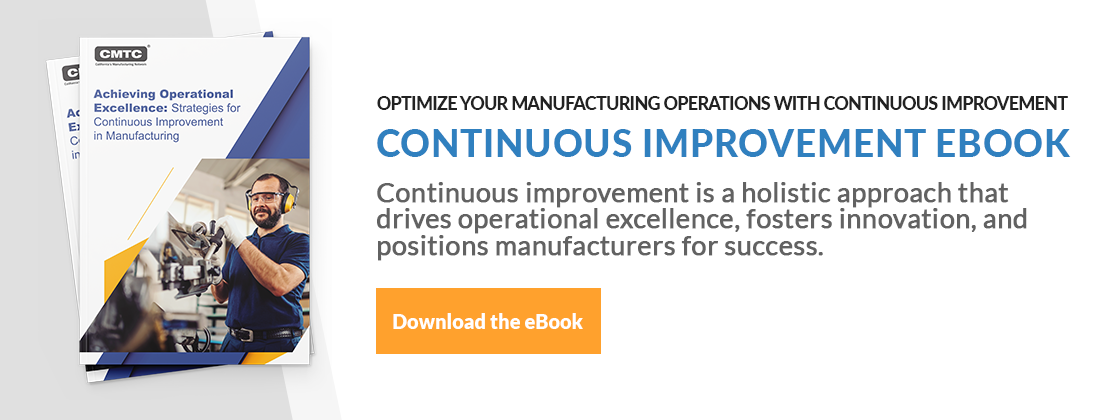July 28, 2021 | Continuous Improvement, Machine Shops
Optimizing Manufacturing Operations on Your Shop Floor

A typical manufacturing process involves numerous moving pieces that each play an important role in your organization’s overall success. Understanding each of these components thoroughly will help identify inefficiencies and areas where your manufacturing operation can be optimized. Let’s dive into some of them a little deeper in order to improve areas of improvement and fully optimize processes to fulfill numerous customer requirements and expectations, achieving superior customer satisfaction.
Quick Links:
- A Breakdown of Typical Manufacturing Operations Processes
- The 5-S Workplace Safety Program
- Performance Metrics
- Optimize Your Manufacturing With CMTC’s Quality Services
A Breakdown of Typical Manufacturing Operations Processes
There are a plethora of considerations made every day in a manufacturing company. From start to finish, a typical process flow entails procuring raw materials, packaging them for shipping to the customer, and many steps in between. This section breaks down how a typical manufacturing operation process plays out from beginning to end.
Confirm Customer Requirements for Design and Technical Specifications
In order to deliver a satisfying product to your customers, understanding their final expectations is essential. Be sure to gain as much information from them regarding their order; this may be as simple as confirming they want a wholestock order or as in-depth as reviewing their project’s goals to understand how your manufacturing can best play a role in their success. If drafts of plans are sent back and forth, keep documentation of the changes to verify you’re both on the same page about what to produce. This conversation between you and your customer sets a solid foundation for delivering exactly what they want and builds your reputation with them as well.
Procure Raw Materials
Before you can produce anything, you need the appropriate materials. It’s vitally important to lay out your Receiving Area so that the intended path of each product avoids cross-traffic and bottlenecks. Part of this should include your analysis of the Turn-Around-Time (TAT) to receive an item, check for the correct quantity, identify any damage, and move the products to stock. To keep tabs on this part of the process, set an average "target time" to unload a typical box of parts and track them to understand the pattern and see if things are moving smoothly or if there are speed bumps along the way.
Another factor to consider when reorganizing and streamlining this process is to determine if you can receive certain items as "Dock to Stock" - i.e., allowing certain parts or components with a good history of quality, delivery, and PO conformance to bypass your inspection process. Minimizing the amount of time an item dwells in your shop, the number of times it is touched, and the distance it travels through the shop before landing in stock will help your overall receiving process.
Initial Inspection of Raw Materials
Now that you’ve received your raw materials, you need to inspect them for quality. Your manufacturing floor should have sufficient lighting in every area to ensure that the mechanical and cosmetic inspections can take place properly, as well as having the appropriate inspection tools and instruments at the relevant point of use. Your quality inspection system should be able to place your low-performing suppliers on “quality probation” due to their low-quality performance and force additional problem resolution - or inspection if need be - at the supplier’s expense. It’s not unreasonable to mandate that additional inspection take place at the supplier’s site if you are experiencing such poor quality that it alters the speed of your production line, which in turn impacts your operational flow and profitability.
Another facet of incoming inspections is for your operations floor team to have a designated area clearly defined to hold non-conforming material (NCM); this material must be segregated, clearly marked as such, and handled separately from all approved materials. Sometimes this could even require a locked cage to prevent the unauthorized removal of NCM. The most egregious error you could make - from a quality standpoint - would be to allow the shipment of known NCM or non-conforming products to your customer; shipping defective products demonstrates carelessness to customers, which can cause your manufacturing business to lose sales.
The Production Phase
The employees at your manufacturing organization should have full competency of their role in the production phase. It’s essential for your manufacturing business that your technicians and operators can describe the critical characteristics of your parts at their particular workstations. Are any of the tolerances especially tight? Do some parts require the use of one particular machine at your company? Might some parts be operating near the limit of your technical ability? If so, that information should be highlighted by the production team.
Your team’s specifically required tools and gauges should be noted as requirements in their work instructions and stored within easy reach at the point of use. All of the team’s measurement tools should be calibrated, certified, and stickered to indicate their go/no-go status. If possible, create and hang up large visual displays of examples of non-conforming parts so that everyone will know what an unacceptable part looks like; these are called boundary samples. Then, along with detailed quality performance graphs and bar charts, convey this data to set each department’s quality priorities and raise the staff's awareness of defects. Fixing defects regularly increases your team’s communication and ensures a streamlined production process.
A preventive maintenance program that covers all key machines, jigs, and build fixtures should be accessible to all pertinent employees. Maintenance records must be maintained at the point of use with service due dates, and these records can be used to adjust intervals to prevent unplanned downtime. Unplanned downtime wrecks your operational process and impacts your financial bottom line.

In-Process Inspection
Adequate lighting to see the defect's details is just as critical in the end as it is in the initial inspection, and the pertinent tools are necessary to position and hold the part for inspection. It’s helpful to have reference color samples and models of correctly assembled products available in the Inspection Area. Require your suppliers to maintain strict lot control identification on their parts and materials using printed labels, tags, travelers, or on the work order itself. Your supplier must be able to demonstrate traceability of their critical-to-quality operations, such as mixing, metal deburring, blending, heat treating, welding, sterilizing, cable-building, etc.
For safety-related parts or parts used in regulated industries, your supplier should also be able to identify the components and raw material lots that went into the finished part or assembly. Any failures from the Final Inspection should get tracked, put into a Pareto chart, and have a root cause determined to be corrected upstream. If not inspecting 100% of the parts or material, your manufacturing floor should have a system in place to plan the percentage of parts inspected vs. the quantity produced, perhaps using statistical sampling. Furthermore, if "master" or "gold" samples are used, you should have a process that prevents the accidental shipping of those samples.
Test the Product
When performing product testing or burn-in during the manufacturing process, be sure to create inspection plans in conjunction with the testing to build a database of specific parts or material failures. Your goal should be to develop and maintain Key Performance Indicators (KPIs) to monitor your customer’s rejections and the yield of assembled products through the final test. You can use statistical sampling to reduce your touch-labor hours spent inspecting parts, in addition to confirming that all critical items are monitored. Finally, error-proof the test process so that no steps are missed in the test sequence. Adequately training your staff to prevent misinterpretation of the test instructions will help to avoid any issues that might arise from situational ignorance.
Rework or Send to Scrap
Your manufacturing facility should minimize dirt and dust in order to prevent the contamination of clean parts. As stated before, your shop floor needs appropriate lighting, and your employees should have cleaning tools available to them at their point of use. The categorization of product defects should be routine, and your operations team should be disposing of waste materials per your local CUPA (Certified Unified Program Agency). When necessary, criteria should be established to determine if or when a part may be reused.
Packaging for Success
Your manufacturing operations should have special packaging requirements that tell the operator what type, size, and special materials are required for packaging a part or material. Packaging materials should be properly stored for cleanliness and protected from moisture to prevent damage or any defects. If a customer requires it, the part number’s revision level should be marked on the box label and shipping documents to confirm that the customer received the correct version. Your manufacturing floor area should ideally facilitate proper packaging with space, cleanliness, light, transport, workbenches, and flow to ensure a smooth operation.
Incorporating Traceability
Another facet of your manufacturing operation should include implementing a system to prevent incorrect parts identification. Barcodes and labels should be verified as "readable" after printing; labels should be printed according to a strategy and controlled with work instructions. An unreadable barcode dramatically impedes your active flow. Furthermore, there should be a procedure in place that ensures the correct label is put on the corresponding part. For regulated industries, any part that can be shipped should have its lot code traceable back to the receipt of raw material for tracking of:
- Customer Satisfaction
- Freight Charges for Expediting and
- Instances of Transit Damage
Shipping to Customers & Delivering Excellent Products
In 2018, the U.S. transportation system moved a daily average of about 51.0 million tons of freight valued at more than $51.8 billion. This incredibly valuable process should be well-defined to streamline operations internally and externally for your manufacturing business. Parts should be handled correctly while various factors like temperature, moisture, dirt, condition of packing material, and the height of box stacking are considered to ensure security and quality during transit. Good inventory management guarantees that parts are stored in the correct location so they can be found. A system should be implemented to verify all parts went through the complete production process and quality control before shipping; a part’s quality status should be evident and unambiguous with a "passed" stamp, or a visual flag moved before delivery.
Whatever resources needed to make this final part of the manufacturing process function smoothly should be maintained; computers, shipping materials, pallets, printers, special UPS printers, pallet wrapping machines, and more should be routinely cleaned, refilled, and available for use. If any of this equipment is unavailable or in disrepair, it will decrease your operational flow and thus impact your profitability.
Part of this final step is to check in with your customers to see how they received the product. Was the product beyond their expectations, or did they have trouble with it? Utilize a rating scale, like the examples in the section further down, to comprehensively evaluate how your manufacturing organization performed in this transaction.

Clean and Safe Facility: 5-S Workplace Program
To further standardize the cleanliness and safety of your manufacturing facility, implement and follow the 5-S workplace program:
Sort the Needed From Unneeded Items
Only the tools and supplies necessary to do the current job should be stored at that work location or should be nearby and "readily retrievable." This means cabinets and overhead storage compartments are well-marked and equipped only with necessary tools and supplies, and all personal items have been removed from the work area. All unneeded or outdated items displayed in the work areas have been removed from the walls, cabinets, computer monitors, and bulletin boards.
Straighten Items Into their Correct Places
The correct places (tool boards, cabinets, overhead compartments) hold all items clean, organized, and labeled; all tools are stored neatly in their proper places, and all parts for in-process jobs are put back into their corresponding locations, such as in bins, boxes, and storage racks. All other work orders remain waiting in line, and in-process jobs remain stored in their appropriate location until needed. Any defective parts are scrapped or contained by the end of the day.
Shine: Keep the Work Area Swept and Clean
All horizontal surfaces should be clean of dirt, oil, and trash - this means no dirty, lint-ridden rags are kept on the benchtops, including the area under and around the bench or work area. The minimal amount of organization tools is needed; no excess parts are stored, and the used tools and equipment are kept clean. Parts benches or small hand tools should be wiped off at the end of every shift. Be sure that the sensitive instruments are covered to prevent contamination or kept in bags if recommended by the manufacturer.
Standardize: A Repeatable Build Routine
Your manufacturing operations should know that all build documentation is kept current, accurate, and complete while also confirming that such documentation has been technically reviewed and approved for use. The correct revisions of build documents, including drawings, prints, and work instructions, should be posted and easily accessible on the bench. Version control has been error-proofed so that out-of-date documents are never used. The quality bulletin board is updated in the work cell or area with major issues, best practices, and photos of proud employees.
Safety: Elimination of Workplace Hazards
The importance of safety on your operations floor includes removing workplace hazards like flammable or combustible materials. Workplace safety also entails educating your employees on fire hazards, the location of fire exits, extinguishers, sprinklers, and more, in case of emergency. Basic safety training regarding power tools, ladders, and electrical components should be provided to all employees. As we learned during the pandemic, PPE requirements should be written into job descriptions; eye protection glasses, flip-down face shields, shoes, aprons, face coverings, and hearing protection are used all day, every day, without prompting.

Sustain To Avoid Regression
Sustainability is also critical for your manufacturing operations. Top management must show their support and commitment to instill these attitudes and your company's culture. Make this culture a way of life through audits, ensure that all workers have been trained, and don't "look the other way" when you see noncompliance. Be sure to use work instructions with pictures to avoid backsliding. Your employees should hold each other to these standards; and train the various departments to audit each other's demonstrated compliance.
Performance Metrics
Consider the following performance metrics when determining how to measure the effectiveness of your manufacturing operations:
On-Time Delivery (OTD)
1. OTD including customer-approved late deliveries:Formula: # PO Line items on time / Total # PO Line items for the month
2. OTD less customer-approved late deliveries:Formula: # PO Line items on time. Total # PO Line items for the month
3. Lead Time:Formula: Avg. actual time from sale to complete order shipment, measured from dock to dock.
Quality
- Percent of conforming product made (not shipped)
- Number of errors attributable to product design
- Percent of excellent “Gold” or "Premium" suppliers
- Number of corrective actions processed per quarter
- Number of complaints about shipping damage
Customer Satisfaction
1. Level of customer satisfaction (on a scale of 1-5)Example: 2019 was 3.2 vs. 2020 was 3.4
2. Net Promoter ScoreExample: On a scale from 0 to 10, how likely are you to recommend our company?
(a) Detractors (0-6)
(b) Passives (7-8)
(c) Promoters (9-10)
3. Customer Change Rate (Churn)
Ex: (customers at start of quarter- at end of quarter) / customers at start of quarter
Optimize Your Manufacturing With CMTC’s Quality Services
Ready to transform your manufacturing operations?
CMTC’s team of quality consultants is made up of certified individuals of diverse backgrounds and skill sets to provide the knowledge necessary to overcome almost any issue faced by California’s manufacturing community. CMTC specializes in Production Effectiveness Solutions for both small and medium-sized manufacturers. We can “expand the reach” of your Quality Department by helping you implement industry best practices in your factory.
For more information on CMTC’s Quality services or to reach out to one of our manufacturing experts, contact CMTC today.
About the Author
Eliot Dratch
Eliot Dratch is a quality, lean and safety consultant who understands that U.S. manufacturing has been the economic engine that raised the living standards and built economic empowerment for the last 6 generations of Americans. Eliot’s work with manufacturers for his entire 30+ year career from different manufacturing sectors allows him to leverage a unique blend of experience for his clients. His goal is always to measurably improve a CMTC client’s productivity, safety and profitability.

